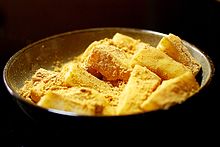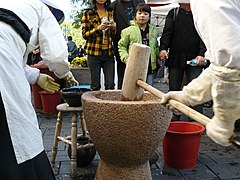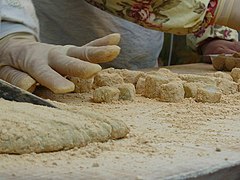Injeolmi
 Injeolmi covered with roasted soybean powder | |
| Place of origin | Korea |
|---|---|
| Region or state | Korean-speaking areas |
| Main ingredients | glutinous rice flour, bean powders |
| Injeolmi | |
| Hangul | 인절미 |
|---|---|
| Hanja | [None] Error: {{Lang}}: Latn text/non-Latn script subtag mismatch (help) |
| Revised Romanization | injeolmi |
| McCune–Reischauer | inchŏlmi |
Injeolmi (인절미, pronounced [in.dʑʌl.mi]) is a variety of tteok, or Korean rice cake, made by steaming and pounding glutinous rice flour, which is shaped into small pieces and usually covered with steamed powdered dried beans or other ingredients.
It is a representative type of glutinous pounded tteok, and has varieties depending on the type of gomul (고물, something to coating rice cake) used. Gomul can be made with powdered dried soybeans, azuki beans, or sesame seeds, or sliced dried jujube. Subsidiary ingredients are mixed into the steamed rice while pounding it on the anban (안반, wooden pounding board). Patinjeolmi (팥인절미), and kkaeinjeolmi (깨인절미) are examples for the former, coated with azuki bean powder and sesame respectively. In ssuk injeolmi (쑥인절미) and surichwi injeolmi (수리취인절미) are artemisia and Synurus deltoides (AIT.) NAKAI) added.[1]
Injeolmi is not only a popular snack but also is considered a high quality tteok, used for janchi (Korean:잔치 ; party, feast, or banquet) in Korea. It is easily digested and nutritious.[2][3] Injeolmi can be stored in a refrigerator and taken out when needed. If the tteok is heated slightly in the microwave, it may taste almost as good as the newly made one.[4]
It is better to use soy beans gomul in summer because it is prone to damage. Red beans gomul(고물) is used a lot in spring, fall, and winter.[5]
The way of making Injeolmis has an important effect on the characteristics of Injeolmis; whether the glutinous rice is Japonica or Japonica/Indica, and whether it is steamed in rice grain, or in rice powder. The characteristics of Injeolmi were investigated through sensory evaluation and Instron Universal testing machine.[6]
Gallery
-
black sesame injeolmi
-
Pounding tteok
-
A lump of injeolmi diced into small balls
See also
References
- ^ "Ttuk, Hangwa - Kinds of Rice Cakes". Korea Agro-Fisheries Trade Corporation. Retrieved 2008-07-04.
- ^ "Pyeingdong Korean cake town". Injeolmi. Invil: Information Network Village. Archived from the original on 2009-08-15. Retrieved 2008-07-04.
- ^ 인절미 (in Korean). Doosan Encyclopedia. Retrieved 2008-07-04.[permanent dead link]
- ^ "Tteok". Korean Overseas Information Service. Archived from the original on 2011-07-22. Retrieved 2008-07-04.
- ^ "인절미(Naver 지식백과)".
- ^ Choe, Eunok (1990). "A Study on the Texture of Injeolmi by Cooking Method". Korean Journal of Food and Cookery Science. 6 (2): 27–36.
External links
- Injeolmi recipe at Tourism Promotion Division, Seoul Metropolitan Government
- (in Korean)Etymology of Injeolmi at Empas / Britannica
- 인절미 (in Korean). Empas / EncyKorea. Retrieved 2008-07-04.




